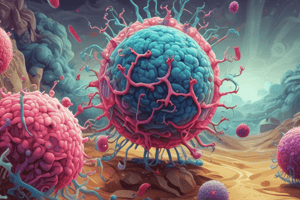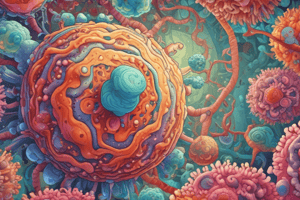Podcast
Questions and Answers
What is the primary route of transmission for poliovirus?
What is the primary route of transmission for poliovirus?
- Blood transfusion
- Fecal-oral route (correct)
- Skin contact
- Airborne droplets
Which of the following is a severe symptom of poliomyelitis?
Which of the following is a severe symptom of poliomyelitis?
- Stiffness in the neck
- Fever
- Acute flaccid paralysis (correct)
- Headache
Which of the following statements about poliovirus is true?
Which of the following statements about poliovirus is true?
- Poliovirus can only be isolated from blood samples.
- There is a cure for poliomyelitis.
- 90% of infections present severe symptoms.
- It is an enterovirus responsible for poliomyelitis. (correct)
What type of vaccine is the Inactivated Polio Vaccine (IPV)?
What type of vaccine is the Inactivated Polio Vaccine (IPV)?
What percentage of poliovirus infections are generally asymptomatic?
What percentage of poliovirus infections are generally asymptomatic?
What is a major complication associated with poliomyelitis that can occur years after the initial infection?
What is a major complication associated with poliomyelitis that can occur years after the initial infection?
Which part of the nervous system does poliovirus predominantly invade?
Which part of the nervous system does poliovirus predominantly invade?
Which of the following is not a method for diagnosing poliovirus infection?
Which of the following is not a method for diagnosing poliovirus infection?
What is the incubation period for poliovirus?
What is the incubation period for poliovirus?
What is the focus of treatment for poliomyelitis?
What is the focus of treatment for poliomyelitis?
Study Notes
Poliovirus Overview
- Definition: Poliovirus is an enterovirus that causes poliomyelitis, a potentially fatal disease affecting the nervous system.
- Types: Three serotypes:
- Type 1 (Mahoney)
- Type 2 (Lansing)
- Type 3 (Leon)
Transmission
- Route: Primarily fecal-oral transmission; can also be spread through contaminated water and food.
- Infectious Period: Infected individuals can shed the virus in their stool for several weeks.
Infection and Symptoms
- Asymptomatic: Approximately 90% of infections are asymptomatic.
- Mild Symptoms: Fever, fatigue, headache, vomiting, stiffness in the neck.
- Severe Symptoms:
- Acute flaccid paralysis (AFP)
- Muscle weakness
- Respiratory failure in severe cases
Pathogenesis
- Entry: Virus enters via the gastrointestinal tract and replicates in the oropharynx and intestines.
- Nervous System Invasion: Can invade the central nervous system (CNS), particularly motor neurons in the anterior horn of the spinal cord.
Diagnosis
- Clinical Diagnosis: Based on symptoms and history of exposure.
- Laboratory Diagnosis: Isolation of the virus from stool samples or throat swabs; detection of viral RNA.
Prevention
- Vaccination:
- Inactivated Polio Vaccine (IPV)
- Oral Polio Vaccine (OPV)
- Global Initiatives: Polio eradication campaigns by WHO and UNICEF.
Treatment
- No Cure: Treatment focuses on supportive care.
- Rehabilitation: Physical therapy may be necessary for recovery from paralysis.
Epidemiology
- Global Status:
- Polio eradication efforts have greatly reduced cases globally.
- Endemic in some countries; outbreaks can occur in under-vaccinated populations.
Key Facts
- Incubation Period: 6-20 days.
- Complications: Post-polio syndrome includes muscle weakness, fatigue, and pain many years after initial infection.
- Public Health Importance: Continued vaccination efforts are critical to prevent resurgence of the disease.
Poliovirus Overview
- Poliovirus is an enterovirus responsible for poliomyelitis, a disease that can severely impact the nervous system.
- There are three distinct serotypes of poliovirus: Type 1 (Mahoney), Type 2 (Lansing), and Type 3 (Leon).
Transmission
- The virus primarily spreads through fecal-oral routes, with potential transmission via contaminated food and water.
- Infected individuals can continue shedding poliovirus in their feces for several weeks, contributing to its spread.
Infection and Symptoms
- Around 90% of poliovirus infections are asymptomatic and do not show noticeable signs.
- Mild manifestations may include fever, fatigue, headaches, vomiting, and neck stiffness.
- Severe complications can arise, such as acute flaccid paralysis (AFP), muscle weakness, and in critical cases, respiratory failure.
Pathogenesis
- Poliovirus enters the body through the gastrointestinal tract, where it replicates in the oropharynx and intestines.
- The virus has the potential to invade the central nervous system (CNS), particularly targeting motor neurons located in the anterior horn of the spinal cord.
Diagnosis
- Clinical diagnosis relies on the presentation of symptoms along with a patient's exposure history.
- Laboratory confirmation is achieved by isolating the virus from stool samples or throat swabs, or by detecting the virus's RNA.
Prevention
- Vaccination is crucial, with two main types: Inactivated Polio Vaccine (IPV) and Oral Polio Vaccine (OPV).
- Global eradication initiatives led by organizations such as WHO and UNICEF are vital in combating polio.
Treatment
- There is currently no cure for poliomyelitis; treatment is centered around supportive care.
- Rehabilitation, particularly physical therapy, may be necessary for recovery from paralytic effects resulting from the infection.
Epidemiology
- Global polio eradication efforts have significantly diminished the incidence of the disease.
- Polio remains endemic in certain countries, with outbreaks possible in areas with low vaccination coverage.
Key Facts
- The incubation period for poliovirus ranges from 6 to 20 days.
- Post-polio syndrome can occur years after the initial infection, leading to renewed muscle weakness, fatigue, and pain.
- Ongoing vaccination efforts are crucial to prevent the resurgence of poliovirus and protect public health.
Studying That Suits You
Use AI to generate personalized quizzes and flashcards to suit your learning preferences.
Description
This quiz provides an overview of poliovirus, its transmission, and the symptoms associated with poliomyelitis. It covers the three serotypes of the virus and explains how the infection can lead to severe outcomes. Test your knowledge on this important public health topic.




